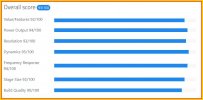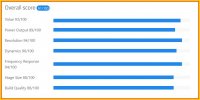theREALdotnet
Major Contributor
- Joined
- Mar 11, 2022
- Messages
- 1,196
- Likes
- 2,063
Regarding this particular effect (not seen in electronics) I would say tonality (of transducers) is not completely characterized when listening to music by (measured) FR nor phase and furthermore is not properly correctable with EQ either. At least not with 'simple' parametric or graphic EQ.
The shown responses will absolutely be evident from the frequency response (which includes both amplitude and phase response, BTW), but not at the frequency of that tone. They are the result of a combination of high- and low-pass filters with their respective damping characteristics which in total make up the response of the device.
A theoretical pair of headphones that passes this tone burst test with a clean response (no over- or underswings) would be one with a flat frequency response all the way to infinity.
The reason this cannot be EQed away completely in practice (it can in theory) is simply that the device is bandwith limited, and to EQ it into producing frequencies it cannot produce would require infinite energy.




